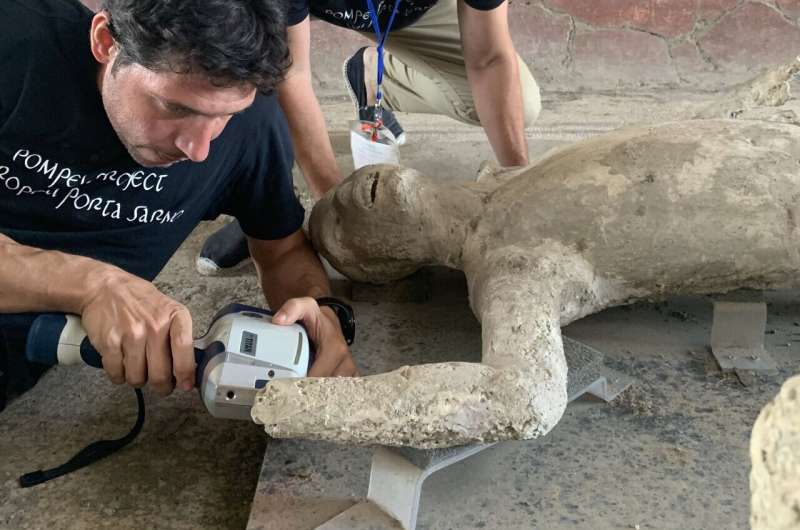August 24, 2023 report
This article has been reviewed according to Science X's editorial process and policies. Editors have highlighted the following attributes while ensuring the content's credibility:
fact-checked
peer-reviewed publication
trusted source
proofread
Analyses of Pompeii victims with X-ray fluorescence suggests they died of asphyxiation

A multi-institutional team of archaeologists, chemists and environmental scientists using portable X-ray fluorescence on victims of the Pompeii eruption in 79 AD finds that they likely died of asphyxiation. The group has published their results in PLOS ONE.
In 79 AD, Mount Vesuvius famously erupted, covering the nearby Roman-era city of Pompeii with ash, pumice and other debris, killing thousands of the people who lived there. Over many years, the city has been excavated, revealing their remains. Many, it has been noted, appeared to have died a peaceful death. In this new effort, the researchers suggest such appearances are deceiving—they believe that those people who were not killed by falling debris or burn injuries likely died of asphyxiation. The team came to this conclusion by testing some of the victims using X-ray fluorescence.
Many of the people of Pompeii were buried by the volcanic material raining down on them. Over time, as the bodies decomposed in the quickly hardening ash, a void formed in the original shape of the dead body. In the 1800s, several archaeologists got the idea to fill the voids with plaster and after it hardened, to remove the ash—that left plaster figures shaped liked the people who had died.
Prior nondestructive testing of such casts showed that the bones of the dead person were hidden within them. Prior research has also suggested that interactions between the bones and the plaster likely led to contamination, making it difficult to reach any conclusions by studying them. In this new effort, the research team used a new approach—portable X-ray fluorescence devices, each small enough to carry to the places where the plaster casts lay and to test them.
By comparing the X-ray fluorescence images with the remains of other deceased people from different parts of the city, the team was able to conclude that the bones inside the casts belonged to people who had died of asphyxiation—not from being pummeled to death by rocks. It also ruled out death due to heat or directly by fire.
More information: Llorenç Alapont et al, The casts of Pompeii: Post-depositional methodological insights, PLOS ONE (2023). DOI: 10.1371/journal.pone.0289378
Journal information: PLoS ONE
© 2023 Science X Network





















